THE SECRETS OF SPARRING METHODOLOGY

Why Can't Kungfu Practitioners Spar with Kungfu Patterns?
Why can't kungfu practitioners spar with kungfu patterns? There are many ways to answer this embarrassing, yet prevalent, question though the different answers actually point to the same reason.
Here are some common answers.
- Because their teachers never taught them.
- Because in all their training they never spar using kungfu techniques.
- Because they only practice solo sets, or at best some two-men sets which they perform for demonstration rather than for combat training.
- Because their school or system has lost its sparring methodology.
- Because they find all other kungfu practitioners using Boxing or Kick-Boxing in their sparring.
- Because they do not practice genuine kungfu. (Understandably, this is a sensitive statement, though it is true.)
We in Shaolin Wahnam are grateful to our lineage of masters that we practice kungfu sparring.
Oddly, we are criticized for practicing kungfu sparring! Some common criticisms are as follows:
- Our kungfu sparring is not kungfu sparring; it is choreography.
- Our sparring is not brutal or aggressive.
- We have no fighting experience.
- It cannot be used against other martial systems like Boxing or Wrestling.
While we are not bothered by such criticisms, it is good to know them. They can, for instance, help us to examine our kungfu sparring from another perspective. Here are our brief answers to these criticisms.
- Our sparring methodology is very comprehensive, ranging from pre-arranged one-step sparring to totally free sparring, including against multiple and armed opponents.
- We are actually proud that we can be combat efficient without being brutal or aggressive.
- Some of our Shaolin Wahnam members have won international titles in free sparring, and many members free spar with martial artists of different styles.
- Our sparring has proven to be effective against other martial systems, including Boxing and Wrestling. (In fact we pay much importance to fighting Boxers and Kick-Boxers, not because of the above criticism but because today many people use Boxing and Kick-Boxing techniques in their fights.)
It is also comforting to know that the above criticisms, though vocal, are only from a small minority. Many other people have written to thank us for sharing our sparring methodology — something that was quite unheard of in the past.
The video clips in this and other series show some of the lessons in our sparring methodology during the Intensive Shaolin Kungfu Course of September 2005. They also show some wonderful spiritual experiences. As usual, the videos were taken as the lessons were, and are released without editing.
You can also find invaluable information on sparring in the video series, How You Could Apply Taijiquan for Combat and Sparring Methodology
This is the third part of the Series. The other parts can be accessed by clicking on the following:
- Part 1 — Internal Force, Kungfu for Combat and Spiritual Expansion are Real, and can Still be Attainable Today
- Part 2 — How do You Use Kungfu for Combat
- Part 3 — Why can't Kungfu Practitioners Spar with Kungfu Patterns?
- Part 4 — Great Kungfu is a Process of Spiritual Cultivation
Flowing with the Opponent's Force
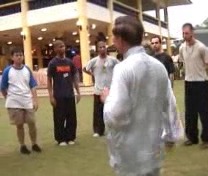
A big-sized student expresses surprise at the internal force of another student, which incidentally answers those who question whether the seemingly gentle movements in sparring are powerful enought for actual combat. Nevertheless, we minimize our force, instead of meeting force head on. We flow with the opponent's force.
The Importance of Right Spacing and Right Timing

This is Sequence 7, “Chop the Hua Mountain”. Here, a new defence technique, “Bar the Big Boss”, is introduced. Grandmaster Wong also highlights the importance of spacing and timing. Charles moves in too close for his attack, and in an impromptu modification Grandmaster Wong fells him onto the ground. In another situation, if Charles moves too fast and too far away before Grandmaster Wong counter-attacks with a chop, Grandmaster Wong would change the chopping attack to a kicking attack followed by a palm strike and an elbow press.
The Necessity of Appropriate Stances
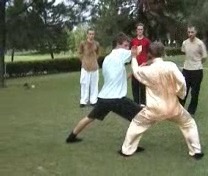
This is Sequence 8, “Horizontally Sweep a Thousand Armies”. While the patterns from Sequences 1-4 are simple as the main aim is to develop skills, the patterns from Sequence 5-8 show progressive sophistication as the main aim is to expand techniques. For example, the response against the opponent's first counter in Sequence 5 employs the tactic of “first defence then counter”, in Sequences 6 and 7 the responses graduate from “first defence then counter” to “defence cum counter”, and in Sequence 8 the response employs the tactic of “no defence direct counter”. Notice that in this “no defence direct counter” appropriate stances are necessary.
When the Soul reaches God
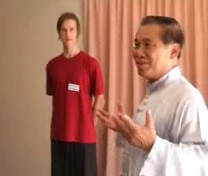
In a meditation session, the course participants feel an inexplicable sense of peace and happiness. Grandmaster Wong explains that the peace and happiness come from inside. It is because the chi flow generated by their practice opens their heart and sets their spirit free. When the spirit expands and be in touch with Cosmic Reality, or in Western terms when the soul reaches God, the spirit is spontaneously peaceful and joyful, because God or by whatever name we may call the Supreme Reality is peace and joy.
Free Choice Within Chosen Set of Sequences

When the course participants are quite fluent in sequence practice, they progress to semi-free sparring. It is semi-free because although the movements are not pre-arranged, they can only use movements from a pre-chosen set of sequences. Here they can use Sequences 1 to 8, which employ hand strikes. Hence, there are no kicks, throws or grips in their sparring. As this is the first time they spar out of routine, the participants are still hesitant in some movements. With systematic practice, their movements will become spontaneous, as shown in later video clips.
Various Steps of Moving In
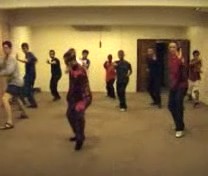
Participants learn to move into an opponent from different distances. They use one step, one and a half steps, two steps, three steps and four steps. The movement is from left leg mode to left leg mode. They may use any hand attacks.
Attacking an Opponent from Various Distances
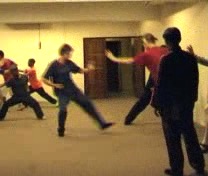
The participants move from left leg mode to right leg mode using various steps and using different hand attacks. Notice that they can now move in to attack an opponent regardless of whether he is just in front or stand across a room
Subtle Funtions of Stances
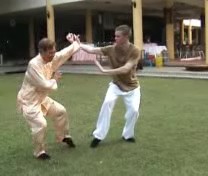
Grandmaster Wong highlights some fine points concerning the placement and movement of stances. Amongst other functions, a good stance enables the practitioner to avoid an attack without moving the feet, free himself from an opponent's immobilization, and prevents an opponent from kicking his groin
Internal Force and Kungfu Combat in a Few Days

After some vigorous chi flow, Wei Joo says that he feels his breathing becomes quicker and believes something is coming out of his body. Grandmaster Wong explains that this is due to cleansing, not just physically but also emotionally. After attending an intensive chi kung course, Wei Joo requested permission to learn Shaolin Kungfu. As Wei Joo had no prior martial art experience, Grandmaster Wong asked him to learn some kungfu from a local instructor first. But he could not find a local instructor, so he learned from Sifu Wong's book. Yet within a few days of the Intensive Shaolin Kungfu Course, he could develop internal force and spar using kungfu patterns!
Making Leg Adjustment when Continuing into another Sequence

What would you do when you have completed applying one sequence but you haven't defeated your opponent? You could continue into another sequence. There is no problem if the leg mode in the last pattern of the first sequence flows naturally into the leg mode of the first pattern in the second sequence, like Sequence 2 continuing to Sequence 3. If the leg mode does not flow naturally, like Sequence 3 continuing to Sequence 2, you just make an adjustment. This video clip shows some examples.
Martial Sports may Not be Suitable for Real Fighting

Martial arts that are practiced as sports may not be suitable for real fighting. It may be a big surprise to many people that Muay Thai, or Siamese Boxing, is one example. In a real fight if you held on to your opponent's neck and threw continuous knee jabs at his ribs, he might take out a dagger and pierce it into your liver. We would not do that to our opponent, but we must be prepared that an opponent may do that to us. Those used to martial sports with safety rules may neglect this important point in combat.
LINKS
Courses and Classes
